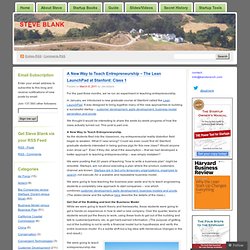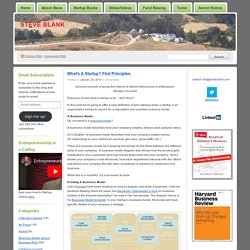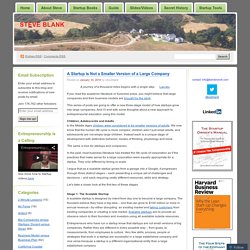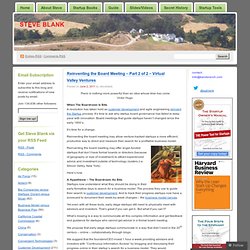

The Movement That Is Transforming How New Products Are Built And Launched. Business Model Generation. Steve Blank. The Lean Launchpad. The Lean LaunchPad – Teaching Entrepreneurship as a Management Science. I’ve introduced a new class at Stanford to teach engineers, scientists and other professionals how startups really get built.

They are going to get out of the building, build a company and get orders in ten weeks. Jon Feiber of Mohr Davidow Ventures and Ann Miura-Ko of Floodgate are co-teaching the class with me (and Alexander Osterwalder is a guest lecturer.) We have two great teaching assistants, plus we’ve rounded up a team of 25 mentors (VC’s and entrepreneurs) to help coach the teams. Why Teach This Class? Business schools teach aspiring executives a variety of courses around the execution of known business models, (accounting, organizational behavior, managerial skills, marketing, operations, etc.)
In contrast, startups search for a business model. Many entrepreneurship courses focus on teaching students “how to write a business plan.” Therefore we developed a class to teach students how to think about all the parts of building a business, not just the product. Class 1 is here. Read: A New Way to Teach Entrepreneurship – The Lean LaunchPad at Stanford: Class 1. For the past three months, we’ve run an experiment in teaching entrepreneurship.

In January, we introduced a new graduate course at Stanford called the Lean LaunchPad. It was designed to bring together many of the new approaches to building a successful startup – customer development, agile development, business model generation and pivots. We thought it would be interesting to share the week-by-week progress of how the class actually turned out. This post is part one. A New Way to Teach Entrepreneurship As the students filed into the classroom, my entrepreneurial reality distortion field began to weaken. Make No Little Plans – Defining the Scalable Startup. What’s A Startup? First Principles.
Success consists of going from failure to failure without loss of enthusiasm.

Winston Churchill Everyone knows what a startup is for – don’t they? In this post we’re going to offer a new definition of why startups exist: a startup is an organization formed to search for a repeatable and scalable business model. A Business ModelOk, but what is a business model? A business model describes how your company creates, delivers and captures value. Or in English: A business model describes how your company makes money. Think of a business model as a drawing that shows all the flows between the different parts of your company. While this is a mouthful, it’s a lot easier to draw. Drawing A Business ModelLots of people have been working on how to diagram and draw a business. Alexander Osterwalder's Business Model Template (At Stanford, Ann Miura-Ko and I have been working on a simplified Silicon Valley version of this model. A Startup is Not a Smaller Version of a Large Company.
A journey of a thousand miles begins with a single step.

Lao-tzu If you read the academic literature or business press, you might believe that large companies and their business models are brought by the stork. This series of posts are going to offer a new three-stage model of how startups grow into large companies. And I’ll end with some thoughts about a new approach to entrepreneurial education using this model. Children, Adolescents and AdultsIn the Middle Ages children were considered to be smaller versions of adults.
The same is true for startups and companies. In the past, most business literature has treated the life cycle of corporation as if the practices that make sense for a large corporation were equally appropriate for a startup. I argue that as a scalable startup grows from a garage into a Google, it progresses through three distinct stages – each presenting a unique set of challenges and decisions – and each requiring vastly different resources, skills and strategy. Reinventing the Board Meeting – Part 2 of 2 – Virtual Valley Ventures. There is nothing more powerful than an idea whose time has comeVictor Hugo When The Boardroom is BitsA revolution has taken hold as customer development and agile engineering reinvent the Startup process.

It’s time to ask why startup board governance has failed to keep pace with innovation. Board meetings that guide startups haven’t changed since the early 1900’s. It’s time for a change.